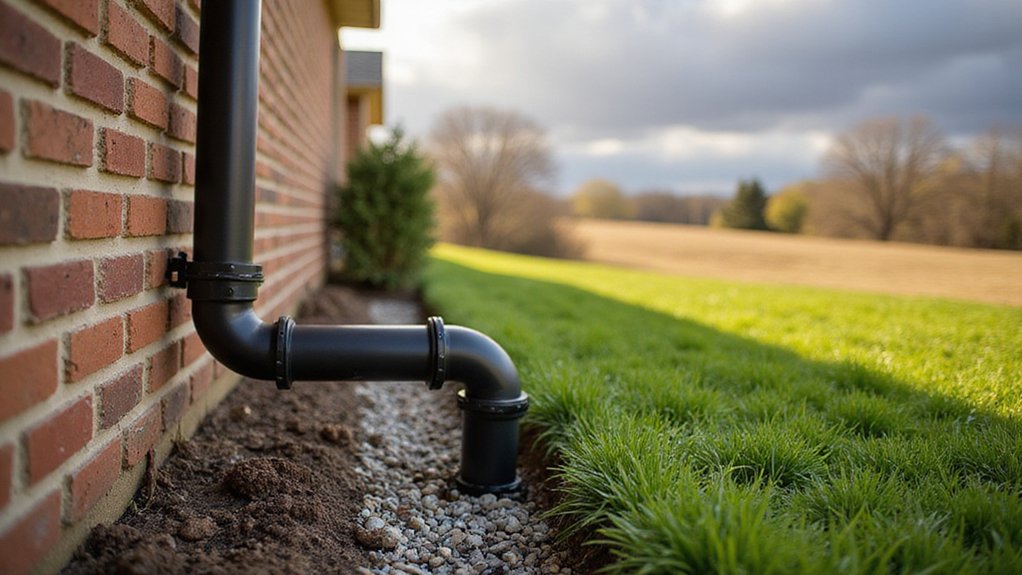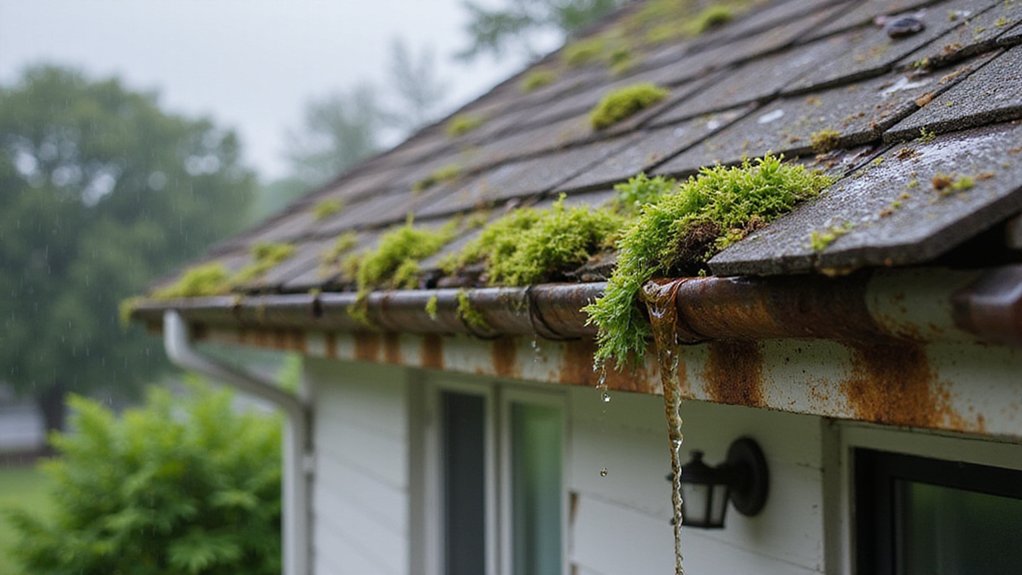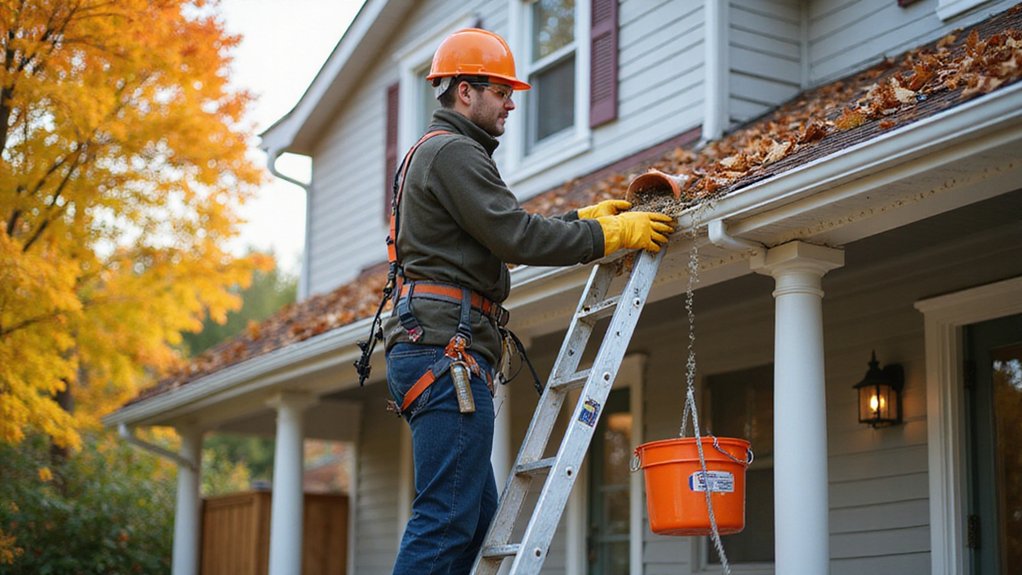If you’re noticing water pooling near your home’s foundation, it’s time to take a hard look at your downspouts. Inspect them for clogs, cracks, or poor positioning that could be directing water too close to your structure. Fixing this issue is critical to prevent costly damage like basement flooding or foundation cracks. Wondering how to assess and solve this problem effectively? Stick around for a step-by-step approach.
Assessing Your Current Downspout Setup
Before you plunge into redirecting your downspouts, take a close look at your current setup to identify potential issues. Start by inspecting each downspout for cracks, clogs, or improper slopes that could disrupt water flow. You’re part of a community that values protecting our homes, so pinpointing these flaws matters. Careful examination of the current gutter system for signs of damage, wear, and poor installation can help identify the right solutions for your home’s specific requirements.
Gathering Necessary Tools and Materials
Once you’ve thoroughly assessed your current downspout setup and identified problem areas, it’s time to prepare for the redirection process by collecting the right tools and materials. Start by purchasing downspout extensions to guide water away from your foundation effectively. Proper gutter maintenance extends the system’s lifespan, so be sure to choose materials that will stand the test of time. Focus on selecting appropriate downspout materials, such as durable aluminum or vinyl, that match your existing system for a cohesive look. You’ll also need a hacksaw for cutting, screws for securing, and a drill for installation. Gather sealant to prevent leaks, ensuring a watertight fit.
With these tools, you’re ready to join our community of proactive homeowners safeguarding their homes.
Measuring the Proper Distance for Water Diversion
Several key ratios key
Choosing the Right Extension or Drainage Solution
Many homeowners face the challenge of selecting an effective extension or drainage solution to manage water runoff from downspouts. You’re not alone in wanting to protect your foundation.
Start by evaluating your yard’s slope and soil type to determine runoff patterns. Consider a concrete channel design for surface water control; it’s durable and directs flow efficiently. Alternatively, opt for buried drainage pipes if you prefer a hidden, low-maintenance system.
Analyze pipe diameter and material to guarantee capacity for heavy rain. Join our community of savvy homeowners by choosing a solution customized to your property’s unique needs.
Installing Downspout Extensions for Optimal Flow
Before you begin installing downspout extensions, make sure you’ve selected a design that corresponds with your yard’s specific drainage requirements. As part of our community of savvy homeowners, you’re taking control to protect your foundation. Precision is key, so follow these steps:
- Measure the Slope: Guarantee a proper downspout angle, aiming for a 1-inch drop per 10 feet to guide water away efficiently.
- Attach Extensions: Use secure extension attachments, like screws or brackets, to prevent leaks.
- Seal Joints: Apply silicone caulk at connections for durability.
With these steps, you’ll achieve ideal flow and safeguard your home.
Testing the New Drainage Path for Effectiveness
Once you’ve installed the downspout extensions, it’s critical to test the new drainage path for effectiveness. Grab a hose and simulate heavy rainfall by directing water through the system. Observe closely, monitoring water flow patterns to guarantee it moves away from your foundation without pooling. Check for any leaks or blockages in the extensions.
Next, focus on evaluating water absorption rates in the drainage area. Note if the ground soaks up water efficiently or if runoff forms. These assessments help our community protect homes, verifying your setup functions ideally to safeguard your property from water damage.
Maintaining Your System for Long-Term Protection
A well-maintained downspout system is essential for long-term protection against water damage. You’ve joined a community of proactive homeowners by redirecting water, but consistency keeps your foundation safe. Stick to a proper maintenance schedule and follow a regular inspection procedure to guarantee peak performance.
Implement these critical steps:
- Inspect Quarterly: Check for clogs or damage in downspouts and extensions.
- Clean Debris: Remove leaves and dirt to prevent blockages affecting flow.
- Test Flow: Pour water through to confirm proper drainage direction.
With diligence, you’ll safeguard your home alongside fellow caretakers for years to come.
Frequently Asked Questions
Can Downspout Redirection Affect My Neighbor’S Property?
Wondering if downspout redirection impacts neighboring properties? You’ve gotta guarantee proper water flow management to avoid runoff issues. Assess your setup carefully; unplanned changes might affect others, so let’s solve this together.
Are Permits Required for Downspout Modifications?
You’re wondering if permits are needed for downspout modifications? Check local regulations, as they often mandate permits for proper installation methods. Don’t overlook potential cost considerations—join our community to traverse these technicalities together.
How Does Soil Type Impact Drainage Solutions?
You’ll find that soil type directly affects drainage solutions. Sandy soils have high soil permeability, enhancing drainage capacity, while clay retains water, impeding it. Assess your soil—join us in tackling drainage challenges together!
Can Landscaping Be Damaged by Redirected Water?
Can<|control704|><|control704|><|control704|><|control704|><|control704|><|control704|><|control704|><|control704|><|control704|><|control704|><|control704|><|control704|><|control704|><|control704|><|control704|><|control704|><|control704|><|control704|><|control704|><|control704|><|control704|><|control704|><|control704|><|control704|><|control704|><|control704|><|control704|><|control704|><|control704|><|control704|><|control704|><|control704|><|control704|><|control704|><|control704|><|control704|><|control704|><|control704|><|control704|><|control704|><|control704|><|control704|><|control704|><|control704|><|control704|><|control704|><|control704|><|control704|><|control704|><|control704|><|control704|><|control704|><|control704|><|control704|><|control704|><|control704|><|control704|><|control704|><|control704|><|control704|><|control704|><|control704|><|control704|><|control704|><|control704|><|control704|><|control704|><|control704|><|control704|><|control704|><|control704|><|control704|><|control704|><|control704|><|control704|><|control704|><|control704|><|control704|><|control704|><|control704|><|control704|><|control704|><|control704|><|control704|><|control704|><|control704|><|control704|><|control704|><|control704|><|control704|><|control704|><|control704|><|control704|><|control704|><|control704|><|control704|><|control704|><|control704|><|control704|><|control704|><|control704|><|control704|><|control704|><|control704|><|control704|><|control704|><|control704|><|control704|><|control704|><|control704|><|control704|><|control704|><|control704|><|control704|><|control704|><|control704|><|control704|><|control704|><|control704|><|control704|><|control704|><|control704|><|control704|><|control704|><|control704|><|control704|><|control704|><|control704|><|control704|><|control704|><|control704|><|control704|><|control704|><|control704|><|control704|><|control704|><|control704|><|control704|><|control704|><|control704|><|control704|><|control704|><|control704|><|control704|><|control704|><|control704|><|control704|><|control704|><|control704|><|control704|><|control704|><|control704|><|control704|><|control704|><|control704|><|control704|><|control704|><|control704|><|control704|><|control704|><|control704|><|control704|><|control704|><|control704|><|control704|><|control704|><|control704|><|control704|><|control704|><|control704|><|control704|><|control704|><|control704|><|control704|><|control704|><|control704|><|control704|><|control704|><|control704|><|control704|><|control704|><|control704|><|control704|>
What Are Legal Implications of Water Redirection?
When redirecting water, you’ve gotta consider legal risks. Local laws might restrict where water flows, and missteps can spark property disputes with neighbors. Research regulations to stay compliant and keep community harmony intact.


